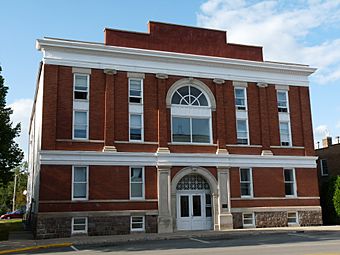Antigo Opera House facts for kids
Quick facts for kids |
|
|
Antigo Opera House
|
|
 |
|
| Location | 1016 5th Ave., Antigo, Wisconsin |
|---|---|
| Area | less than one acre |
| Built | 1904 |
| Architect | Jeffers, J. H., & Co. |
| Architectural style | Classical Revival |
| NRHP reference No. | 84003699 |
| Added to NRHP | January 12, 1984 |
The Antigo Opera House is a special old building in Antigo, Wisconsin, United States. It was built a long time ago, in 1904. This building was once a busy place for shows and music. Today, it has a new purpose as an apartment building.
Contents
What is the Antigo Opera House?
The Antigo Opera House is a historic building made of brick. It was designed by an architect named J.H. Jeffers. He built it in a style called Classical Revival. This style often uses ideas from old Greek and Roman buildings.
A Place for Shows and Music
When it first opened, the opera house was a big deal. It could hold 1100 people! People would come to watch operas and concerts. It was a main spot for entertainment in Antigo.
From Entertainment to History
Over the years, the building changed. During World War I, it was used as an armory. An armory is a place where military groups store weapons and train. After that, it became an apartment building.
A Special Building Style
The Classical Revival style means the building looks grand. It might have tall columns or fancy decorations. These details make it look like important buildings from ancient times. This style was popular for public buildings.
Protecting History
Because of its history and unique style, the Antigo Opera House is important. It was added to the National Register of Historic Places on January 12, 1984. This means it is recognized as a special place that should be protected.



